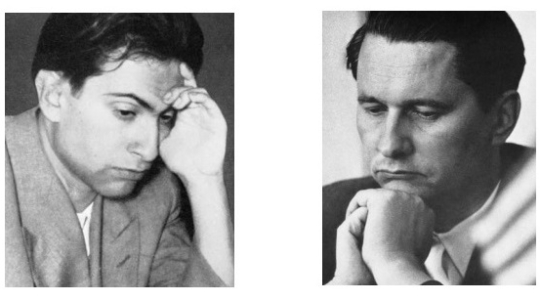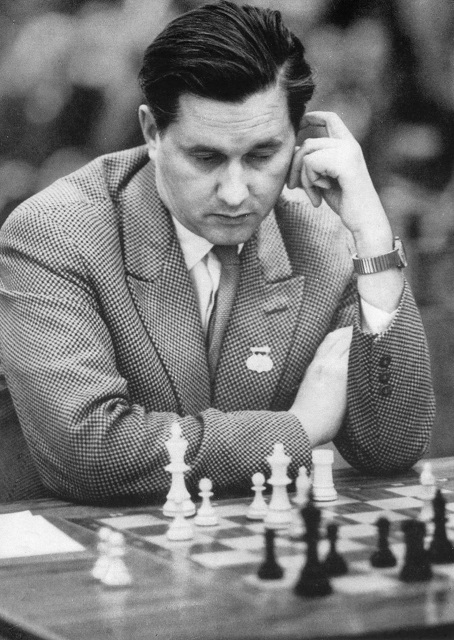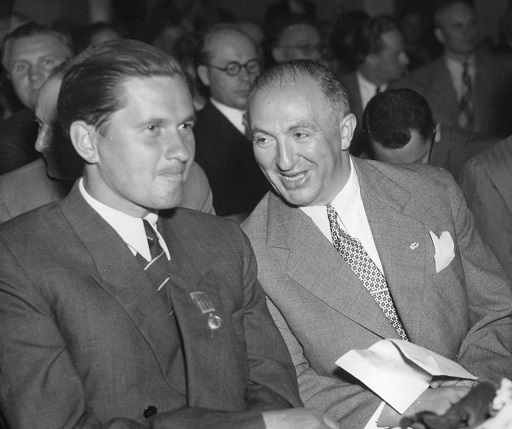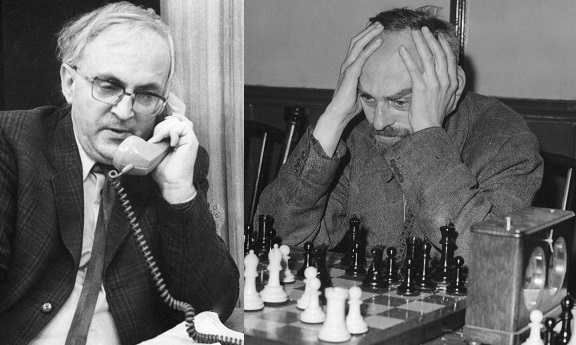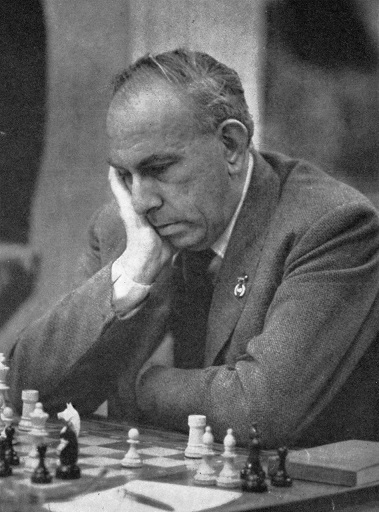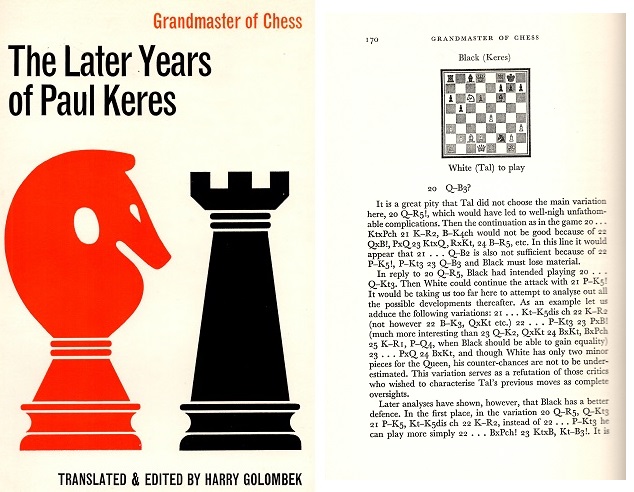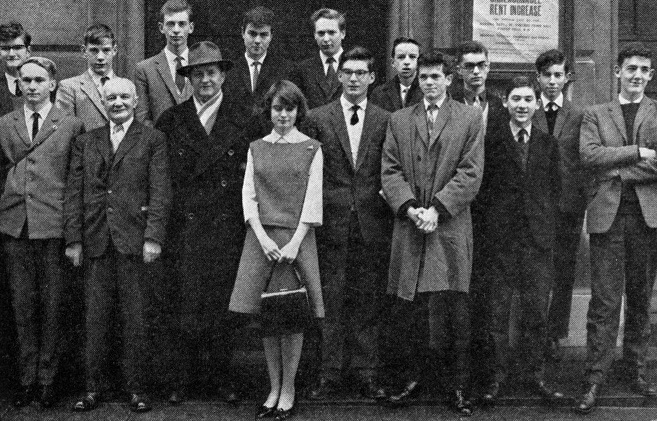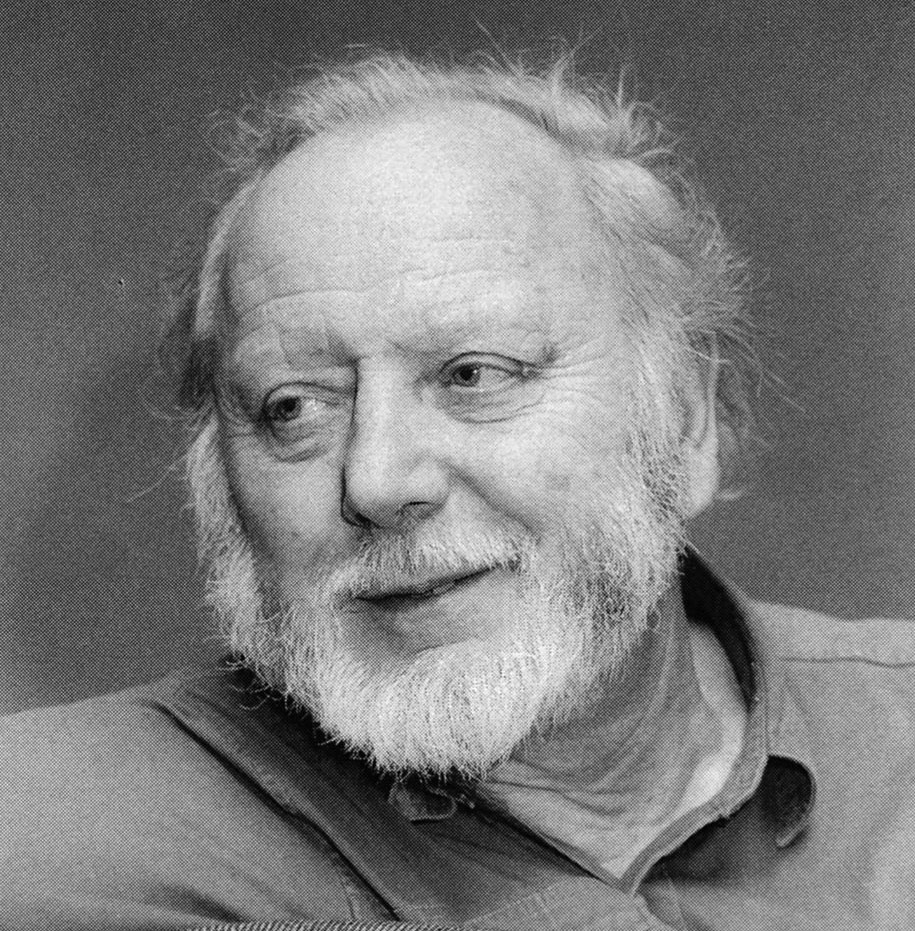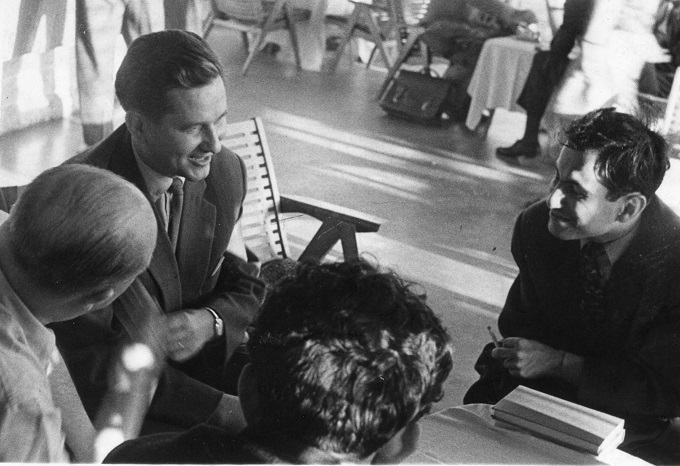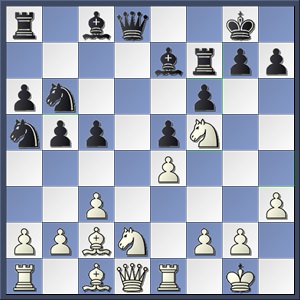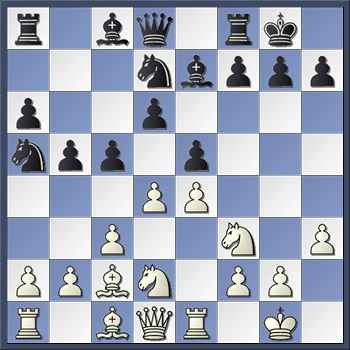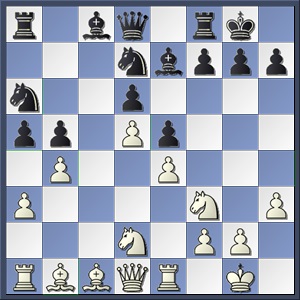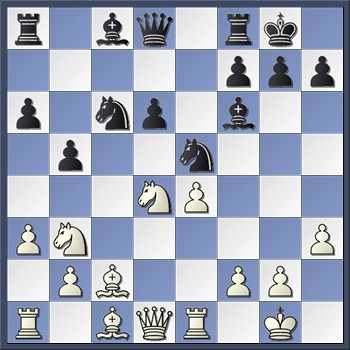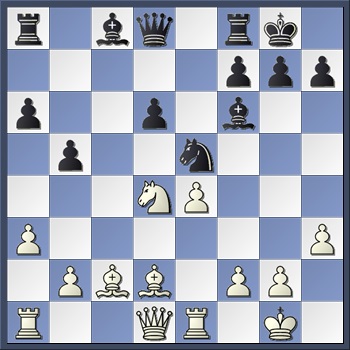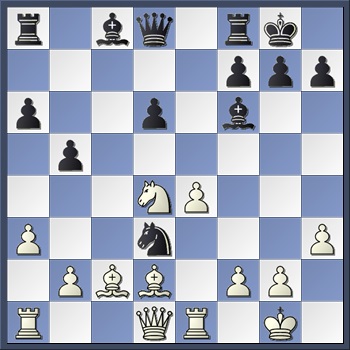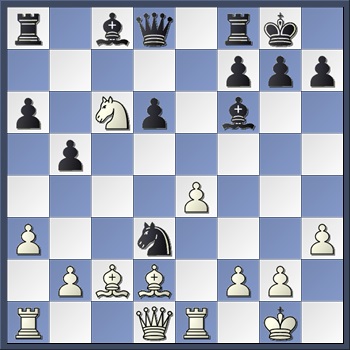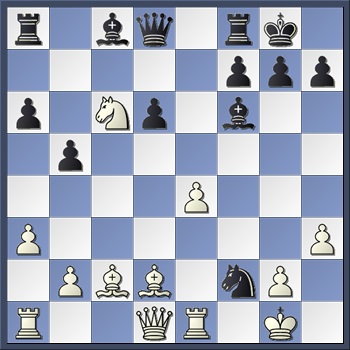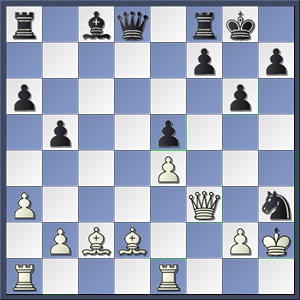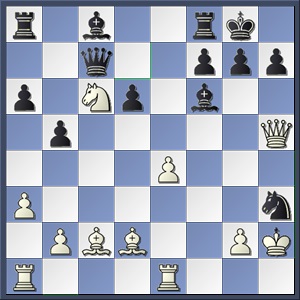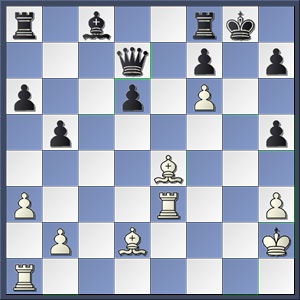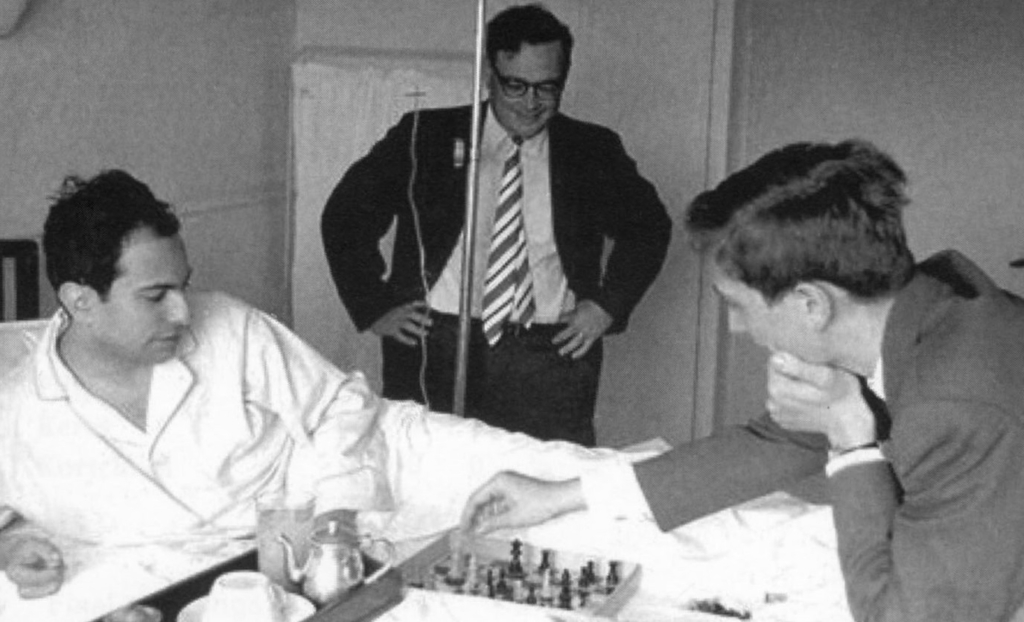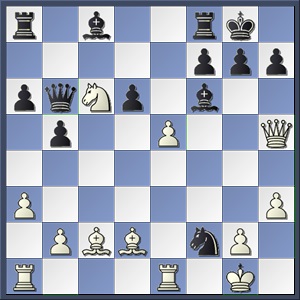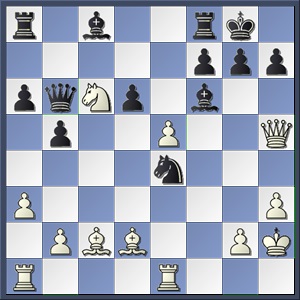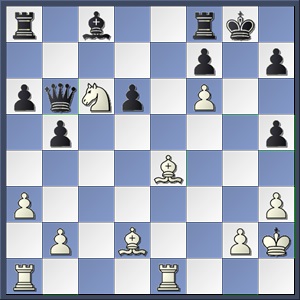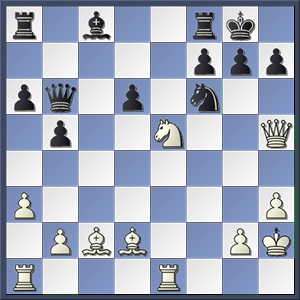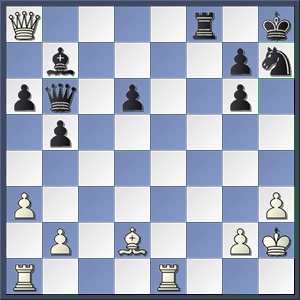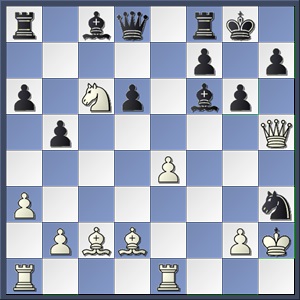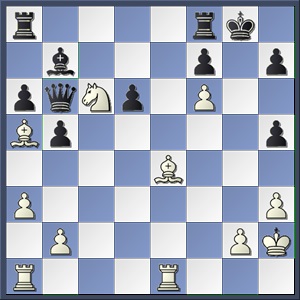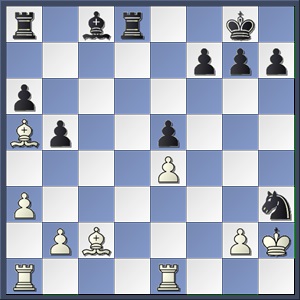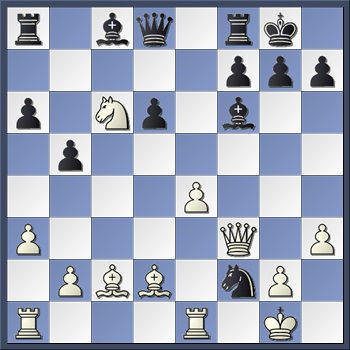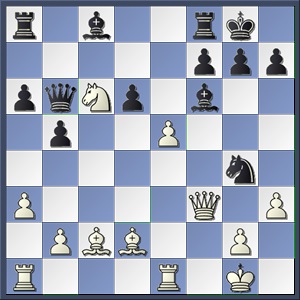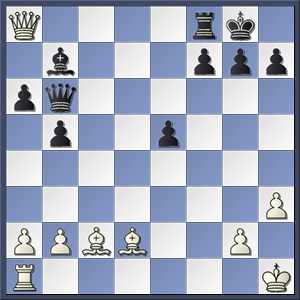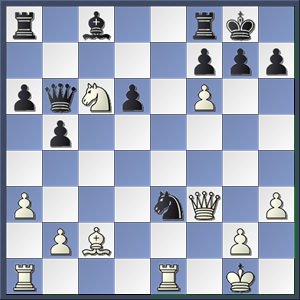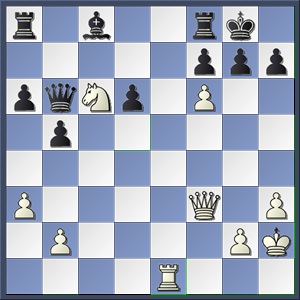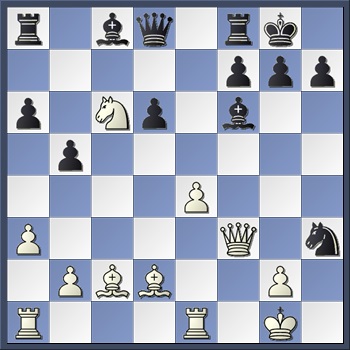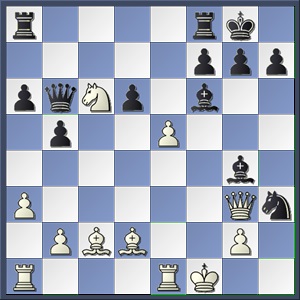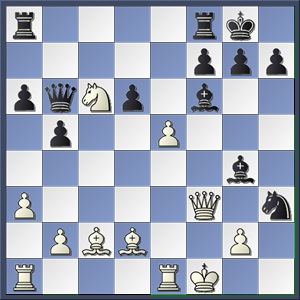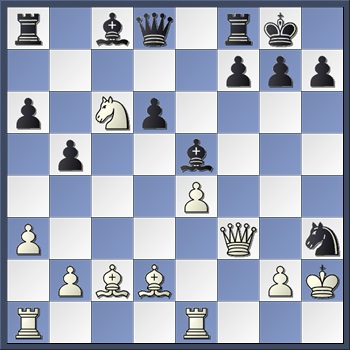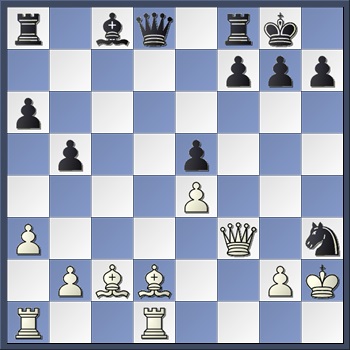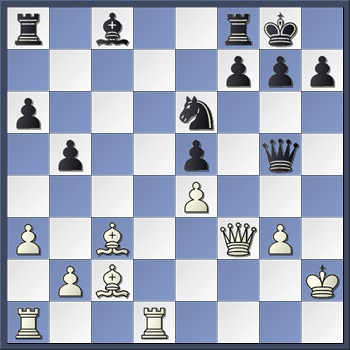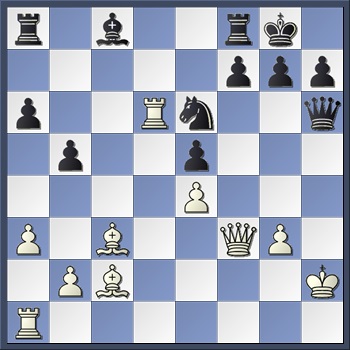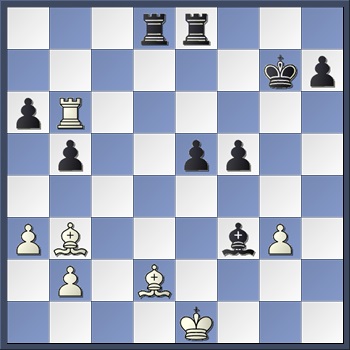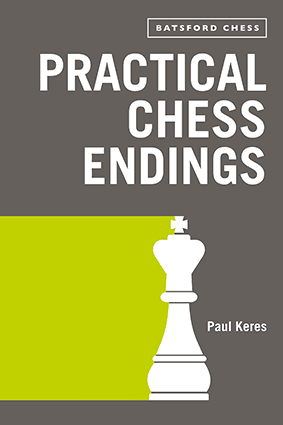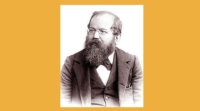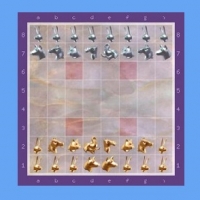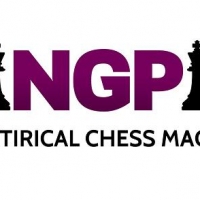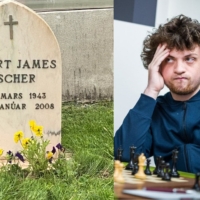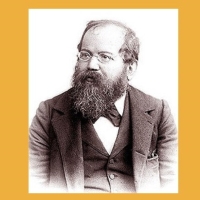Jimmy Adams
In The Treasury of Chess Lore, compiled by Fred Reinfeld, a long time ago I read an article ‘Recollections of Alekhine’ by Harry Golombek, which included the following sensational revelation:
‘. . . I was the editor of the book Alekhine wrote on his return match against Dr Euwe in 1937. He sent me the manuscript by airmail from South America, but an accident happened to the mail and the manuscript eventually reached me with six sheets missing. The publishers were anxious to send the copy to press as soon as possible so as not to lose the topical value of the book, and Alekhine was on tour in South America with no fixed address. Had I written to him for the missing annotations it might be anything up to six months before I heard from him. So I set to, and, imitating his style as best I could, annotated a game and a half myself. Alekhine never discovered what had happened and in fact reproduced my notes as his own in his second collection of games, My Best Games of Chess. Needless to say, I am quite proud of this assimilation of my work with Alekhine’s and, looking back now, it is clear to me that I learned a great deal when editing the match book in question.’
Way back in the 1970s I asked Harry Golombek why he thought he could get away with this and he told me that since he was a schoolboy he had amused himself by copying the writing styles of other chess writers, such as Tarrasch, Réti and Nimzowitsch, and found it quite easy. What he found difficult was developing an individual and pronounced writing style that was uniquely his own.
Well, it seems to me that history repeated itself a quarter of a century later, when Golombek was translating Paul Keres’ best games collection. . .
* * * * *
Paul Keres – the strongest player of his generation never to have become world champion
Keres’ chess autobiography, covering his career from 1931 to 1958, first appeared in Estonian in 1961 under the title Valitud Partiid (Selected Games). By the following year he had also prepared a translation into German, a language in which he was fluent. At Schiphol Airport, en route to the Candidates tournament in Curaçao, Keres passed the manuscript to his long-time friend Max Euwe, who arranged for it to be published in Amsterdam by ten Have. This Dutch company had a good track record in handling chess books and duly produced a splendid hardback edition in German and with the full complement of one hundred deeply annotated games.
A few months later, in October 1962, there were further developments. During the Olympiad at Varna, Miguel Najdorf offered to help organise a Spanish translation of Keres’ book and bring out an edition in Buenos Aires. The well-chosen translator turned out to be FIDE Arbiter Estanislao Zaks, who did a wonderful job, as did the experienced Argentinean chess publisher Sopena who presented the work to Latin American readers in an equally excellent single 500-page volume under the title El Ajedrez como yo lo juego (Chess as I play it) at the very beginning of 1964, not long before the German language edition Ausgewählte Partien (Selected Games) came out.
The Estonian, German and Spanish editions of Keres’ Best Games
The matter of producing an English language edition was of course also on the agenda and had an interesting history.
Coincidentally, at this time, England team member Bob Wade had been energetically exploring the possibility of Keres undertaking a simultaneous exhibition tour of the British Isles. Bob was a very enthusiastic chess teacher and was eager to give British juniors the opportunity to cross swords with one of the world’s greatest ever grandmasters and also someone they could look up to as a role model. Because of his elegant appearance, engaging personality, gentlemanly manner and attractive style of play, Keres was extraordinarily popular in England, a country which he had visited many times to compete in pre- and post-war tournaments at Margate and Hastings as well as Great Britain v Soviet Union matches in London. Moreover his brilliant games were widely publicised thanks to the chess magazines of the day and the upbeat book by Fred Reinfeld, Keres’ Best Games of Chess, which was praised even by Keres himself.
Like so many others, Miguel Najdorf never got a clear answer to his question: “Paul, were you really forced to lose those games to Botvinnik?”
It was unheard of in those days for a Soviet grandmaster to make a lone and privately arranged visit to a foreign country. However, Wade had managed to secure influential and financial support from Dennis Milner, founder of the British-Soviet Friendship Society, to whom he had been introduced in the early 1950s by former British Champion William Winter – a self-proclaimed Communist but equally an avowed British patriot!
The practically minded Milner, an electrical engineer by profession, was also a Communist sympathiser but at the same time a pacifist who had already spent twenty years actively seeking closer cultural ties between the UK and the USSR. He had visited Russia numerous times and even given talks on Radio Moscow. On occasion he hit the headlines, such as when he was jailed for a few months after piloting a light aircraft over a US airbase in Berkshire, west of London, and dropping leaflets in support of the ‘Women of Greenham Common’ who had set up a permanent encampment around the site in protest against the deployment of cruise missiles there. Then again, fiercely independent by nature even in their 80s, Milner and his wife, both campaigners for the right to die with dignity, gassed themselves in a suicide pact, leaving a note that they did not wish to be an encumbrance to anyone in sickness and old age.
Bob Wade (left) had been introduced to the British-Soviet Friendship Society by the Communist William Winter (right)
On a more cheerful note, Milner’s most celebrated moment of glory came when he presented Yuri Gagarin, the first man to travel into space, with a suitcase(!) during his official visit to Britain in 1961. Of course, the joke was not lost that Milner was already equipping Gagarin for his next trip – a longer journey to the moon! But, from a serious perspective, in this sensitive period of the Cold War with its impending Cuban Missile Crisis, the Soviet authorities were impressed by Milner’s activities and also the warm and even rapturous welcome their spaceman had received from the British public. This put them in the frame of mind to deliver another propaganda coup by allowing the unique visit by Keres to go ahead.
Keres’ popular tour of the UK followed that of Yuri Gagarin, the first man in Space
(Photo: Arto Jousi, via Wikimedia Commons)
Provisionally, on being approached in Varna, Keres was happy to accept Wade’s invitation, which he thought he could fit in before a scheduled visit to Sweden. However the trip was only confirmed later after both the Soviet and British Chess Federations gave it their official blessing. Incidentally, Bob Wade was well known to the Russian chess community as he ran a chess column in the left wing, Daily Worker, which had been handed over to him by an ailing William Winter in 1955 and which was the only British newspaper on sale to the public in the Soviet Union! On one occasion I asked Bob if he was a Communist and he flatly denied it, telling me that at the Capablanca Memorial tournament in Havana 1963, he even expressed his displeasure at Ludek Pachman for taking the stage at the closing ceremony and making a speech extolling the virtues of Communism. As is well known, a few years later, when Russian tanks rolled into Prague, Pachman completely changed his views and his outspoken protests landed him in jail, shortly after which he defected to the West.
Harry Golombek organised the English translation and publication of Keres’ Best Games and Middlegame books
Anyway, further dialogue with Keres at the Olympiad then led on to the matter of translating his collection of best games into English. And here Harry Golombek, another England team member and long-time friend of Keres, had no hesitation in offering his services. Golombek was one of the heroes who had helped to crack the wartime Enigma code at Bletchley Park and had an excellent command of German, so was ideally suited to this task of translation. Moreover he was a famous chess author in his own right as well as being chess columnist for The Times and thus in a strong position also to obtain a publisher for the book in London. In this way, Golombek provided even further incentive for Keres to come to the UK, where contractual terms could be negotiated and settled.
And there was still more to discuss. Keres mentioned he had co-written another book with Alexander Kotov, which had already appeared on the shelves in Sweden under the title Konsten att vinna i schack (The art of winning at chess). But again this presented no problem as the multilingual Golombek readily agreed to deal with that too and his English translation from Swedish duly appeared in 1964 under the title The Art of the Middlegame, published in paperback by Penguin. Even today this work is highly regarded and seen on ‘all-time favourite chess books’ lists, as never before had a grandmaster so meticulously revealed his step-by-step thought processes when analysing positions.
The choice of Penguin was no chance happening. In its first ten years, from 1954 to 1964 over 190,000(!) copies of Golombek’s chess primer The Game of Chess had been sold under the Penguin imprint. Then, for reprint after reprint, Golombek had always been willing to update the book and in fact, by the time of the publication of the final edition, just before his death, he claimed it had sold a million. He was probably right, bearing in mind it had benefited from twenty more years of sales which included the fantastic Fischer-Spassky boom period.
A monumental work like Keres’ best games, however, needed to be in hardback for durability and to meet the requirements of libraries. Therefore Golombek turned to Herbert Jenkins who specialised in such books, thus somehow working in parallel with Penguin. In fact that same year Herbert Jenkins had already brought out a hardback edition of The Game of Chess to be sold to more discerning customers alongside the paperback version!
But the 60s was also a time of turmoil in the British publishing industry, with numerous amalgamations, takeovers and formations of giant parent companies. Herbert Jenkins was soon to become Barrie and Jenkins, and newly imposed financial constraints meant that Golombek had to reduce the number of Keres’ best games from 100 to 75 and then split the book into three smaller volumes, which were eventually brought out over a six-year period. These were entitled, respectively, Grandmaster of Chess: The Early Games of Paul Keres (1964), The Middle Years of Paul Keres (1966) and The Later Years of Paul Keres (1969). Of course this was not a very satisfactory state of affairs, although it was offset somewhat in the 1970s when the American company Arco put the three books together to make it into one massive paperback, and this did look impressive! Nevertheless, unlike their foreign counterparts, English-language editions of Keres’ original best games book have remained abridged to the present day.
So the tour went ahead and proved to be an enormous success, thanks in great part to the enthusiastic support of the chess clubs and venues hosting the simultaneous exhibitions.
Keres’ first simultaneous display on his arrival in the UK was against a strong line-up of London Juniors at St Pancras Town Hall
Back row: A.Whiteley, D.Floyer, P.J.Collins, P.J.Adams, R.C.Vaughan, K.B.Harman, D.Parr, D.N.L.Levy. Front row: M.V.Lambshire, A.E.Hopkins (who selected the team), Paul Keres, Miss D.Dobson, R.E.Hartley, C.B.Gillman, W.R.Hartston, P.N.Lee (Photo: A.M. Reilly © British Chess Magazine)
Keres made his first public appearance in London on 25 November 1962 and immediately met with stiff resistance. In a gruelling five-hour session at St Pancras Town Hall – specifically chosen by Milner by virtue of its history of left wing socialist councillors who flew the Red Flag over the building on May Day! – he lost ten games and drew six out of a total of thirty played against the London juniors. I was watching the exhibition and noticed that although Keres arrived looking fresh and much younger than his years, after a while he showed visible signs of eye strain. I believed him when he said afterwards that he had found it difficult to play in the dimly lit, high-ceilinged Victorian building with chess pieces of different shapes and sizes and chess boards of different colours! Today’s uniform plastic chessmen had yet to come on the market and the sets had to be borrowed from chess clubs in the area.
The next day he lost another six games against a strong line up at London University but after that he got into his stride and achieved consistently high percentages throughout England and Wales.
For decades, Ken Whyld kept silent about his private conversation with Keres
(© Mark Huba)
In Nottingham he lost just one game to the co-author of the standard reference work The Oxford Companion to Chess, Ken Whyld, who then invited Keres to a private dinner. It was here that the oft-quoted admission was made by Keres that he would have been in serious trouble if he had been responsible in any way for Botvinnik not winning the world championship tournament in 1948. Indeed, as reported in the magazine Life in Estonia, Andrei Zhdanov, then regarded as successor-in-waiting to Stalin, received a document endorsed at the highest level which stated: ‘Herewith we present the proposal to include Keres as a participant at the world chess championship … Considering the fact that Keres has a great chance to achieve second or third place at the tournament and that the world’s chess media considers him to be one of the strongest players in the world, we consider it right to allow Keres to take part in the tournament.’
Towards the end of the tour Keres travelled to Dublin where he was given a typically hearty Irish welcome and even appeared on television. But demand eventually outstripped supply and the Estonian grandmaster finally ran out of time and had to cancel an intended visit to Scotland in order to meet his pre-arranged obligations in Sweden. In nine consecutive days Keres had played in nine different venues all over the country with a grand total of 179 wins, 27 draws and 27 losses.
The Tal v Keres game was a topic of analytical discussion for many years in those pre-chess-computer days
Already by now Keres had started work on a translation of his best games for publication in the Soviet Union and when he met Golombek at London University he gave him a batch of supplementary sheets containing five extra games, annotated in Russian, to update the copy of the German manuscript which Euwe had sent on to him earlier. And it is specifically the English translation of one of these extra games, the dramatic encounter Keres versus Tal at the Candidates tournament in Curaçao in 1962, that appears to be seriously flawed and in places even contradicts what Keres actually wrote in his notes in Sto Partiĭ (One Hundred Games) published in Moscow in 1966. I really do believe that Golombek lost some of the pages and replaced missing annotations with his own comments, just as he had done with Alekhine twenty-five years earlier.
Perhaps, on reflection, all this should come as no surprise as Golombek was a confirmed bachelor and repeatedly complained that his housekeeper kept moving things around and he couldn’t find anything. Then there was the time the decorators came in and randomly tossed his papers and books in boxes all over the place. . .
The fact that Golombek promptly sent his Russian to English translations of these extra games to Sopena meant that his substitute annotations also appeared in the Argentinean edition, thus giving it a grand total of 105 games.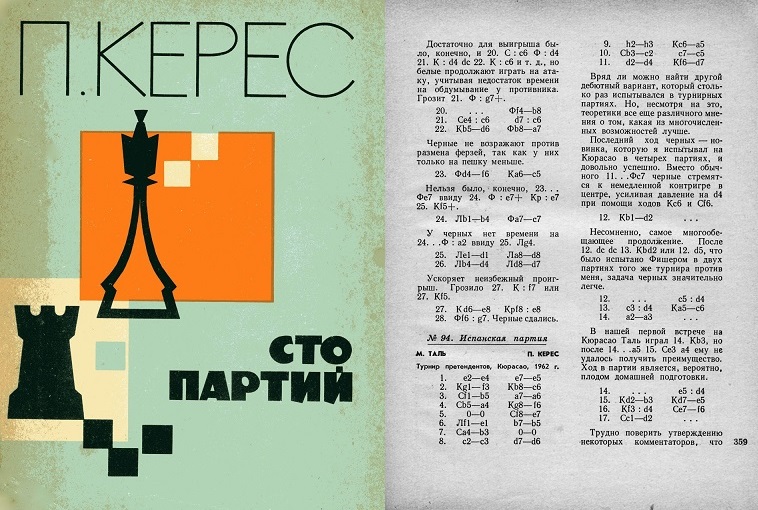
The later Russian edition of Keres’ book, Sto Partiĭ, contained material updated to 1965
Anyway, here are Keres’ notes, translated for the first time into English from his Russian best games book Sto Partiĭ. Also included are Tal’s annotations to the same game in the Latvian magazine Shakhmaty shortly after the Curaçao tournament, together with other related material on this rather special game played between two great chess tacticians from the Baltic. It is now up to Kingpin readers to draw their own conclusions whether or not they agree with me that Golombek’s comments were indeed fake annotations. Incidentally, the very same annotations subsequently appeared without question in John Nunn’s algebraic edition, Paul Keres: The Quest for Perfection, published by Batsford in 1997, and also in Zenón Franco’s very nice recent addition to the Everyman list, Keres: move by move.
Note: to facilitate reading and comprehension we give the notes by Keres in purple, Tal in blue, and Golombek green.
* * * * *
Keres writes in Sto Partiĭ:
‘The next year, 1962, gave me the opportunity once again to try my luck in a struggle for the world championship. Second place in the Candidates tournament of 1959 had given me the right to play in Curaçao without any preliminary qualification.
The hot climate of this island gave the tournament an individual character. If we look at the final tournament table, then what is striking is the great number of draws. Evidently it was too difficult for the majority of the contestants to play all 28 games at full strength and in a competitive manner.
The course of the struggle in this interesting contest was rather upset by the illness of Tal, who was not able to keep going until the end of the tournament. The main pretenders for first place then proved to be the other four Soviet grandmasters, who up to the middle of the competition had formed a tight group. Then Korchnoi fell away, whereas Geller, Petrosian and I continued an even struggle to the last round. I will not go into further detail, as this is all well known. However, in the final round, which took place under very nervous circumstances, it finally became clear that Petrosian’s half point lead had earned him the right to contest a title match with world champion Botvinnik.
In the book the reader will find two games from the tournament; those against Benko and Tal. The combinational complications in the latter encounter were for a long time the object of debate among commentators and I hope that the annotations will help give a more or less objective assessment.’
Mikhail Tal – Paul Keres
Round 16, Candidates tournament, Curaçao 1962
1 e4 e5 2 Nf3 Nc6 3 Bb5 a6 4 Ba4 Nf6 5 0–0 Be7 6 Re1 b5 7 Bb3 0–0 8 c3 d6 9 h3 Na5 10 Bc2 c5 11 d4
Tal started his annotations with a summary of the opening:
‘About half a century ago Chigorin’s signature move 11…Qc7 was considered obligatory. Since then the resulting positions have been analysed up to the 20th-25th move and practice in recent competitive play has shown that White has the more pleasant prospects. Also here, side by side with the usual 11…Qc7, into the arena have entered such continuations as 11…Nc6 and 11…Bb7, which were not lacking in a certain individuality but often transposed into the Chigorin Defence, as sooner or later the black queen would nevertheless be developed on c7. In the present game Keres tries a system that was clearly prepared specially for the Candidates tournament.’
Golombek too, in his translation of Keres’ autobiography The Later Years of Paul Keres, right from the start introduces a comment which is purely his own:
‘This position has occurred thousands of times in various tournaments and there is hardly a single continuation here that has not been exhaustively analysed and tested in practice. Usually Black continues with 11…Qc7, and then, after 12 Nbd2, he has a rich choice of different methods of development at his disposal. In the present game Black tries a new type of defence in which the idea is to dispense with the defensive …Qc7 move.’
But Black’s next move was not really ‘a new type of defence’ it was a new method of counterplay, as is made clear from what Keres really wrote in his first note…
Keres:
‘It is hardly possible to find another opening variation which has been played so many times in tournament games. But, despite this, theoreticians are still of different opinions as to which of the numerous possibilities is best. Black’s last move is a novelty, which I tested in Curaçao in four games, and quite successfully. Instead of the usual 11…Qc7 Black strives for immediate counterplay in the centre, increasing pressure on d4 with the help of the moves …Nc6 and …Bf6.’
Golombek, however, falsely attributed the following version to Keres:
‘I tried this system for Black in three games at Curaçao, counting a transposition even in four, and obtained the excellent result of three points with it. This tends to show that it is not so easy for White to find a promising line against it.’
This left Keres wide open to criticism for something he never wrote! In his My 60 Memorable Games, Fischer challenged Keres’ (but really Golombek’s) annotation:
‘Now it is not easy to find a satisfactory continuation for White (KERES). Keres’ novelty, introduced on this occasion, has since become quite fashionable. I was – and still am – unimpressed. Black loses time redeveloping his knight to b6, but the K-side is weakened by its absence and it’s questionable whether the knight is not better where it stands originally.’
Incidentally Fischer is quoting the words ‘satisfactory continuation’ – instead of Golombek’s ‘promising line’ – from the Argentinean book as The Later Years of Paul Keres had not yet been published when he wrote this.
Tal added his opinion of the new line:
‘Undoubtedly a very principled continuation. Black defends the e5 pawn, freeing the f6 square for his bishop (from where it will exert pressure on the d4 point). From d7 the knight can occupy the b6 square (whilst maintaining pressure on the centre) or make its presence felt on the central e5 square (after an exchange on d4).’
12 Nbd2
Golombek now strays even further from what Keres actually wrote by stating:
‘The text-move is undoubtedly the normal method of development, and certainly more promising than the colourless line 12 dxc5 dxc5 13 Nbd2, which Fischer tried against me. Probably Fischer himself did not entertain so high an opinion of the strength of this continuation, even though he won the game in question, since in a later game he abandoned 12 dxc5, and closed the centre with 12 d5.’
As a consequence poor Keres again had to take the rap for Golombek’s manufactured text, as revealed by a footnote which John Nunn inserted at this point: ‘Fischer responded in My 60 Memorable Games with the comment “According to that logic, Keres must not be convinced of the correctness of 11…Nd7, since he later varied with the old 11…Qc7 (against Gligoric at Hastings 1965)”.’
You see, what Keres actually wrote was simply:
‘Undoubtedly the most promising continuation. After 12 dxc5 dxc5 13 Nbd2 or 12 d5, which was tried by Fischer in two games in the same tournament against me, Black’s task is considerably easier.’
There was no mention of the line being ‘colourless’ or that ‘Fischer did not entertain so high an opinion. . .’
In any case, Golombek’s version is inappropriate as Fischer did play 12 dxc5 again, versus Ivkov in Havana 1965. In My 60 Memorable Games he writes after the subsequent moves 12…dxc5 13 Nbd2
‘13…Qc7?: ‘This is supposed to lead to trouble. (Since 14 Nf1 Nb6 15 Ne3 Rd8 16 Qe2 Be6 17 Nd5! led eventually to a win for White in Fischer–Keres, Curaçao 1962.) If such a natural developing move is bad, then what kind of a position is this for Black? At the time Boleslavsky in his notes gave “13…f6!=” and this cryptic evaluation apparently cowed the chess world into abandoning 12 dxc5 – until very recently. After 13…f6 14 Nh4 Nb6 15 Nf5 Rf7 (Fischer–Ivkov, Havana 1965)
16 Qg4! (instead of my 16 Nxe7+) 16…Kh8 17 h4! threatening h5 followed by Nf3-h4 is in White’s favour: e.g., 17…g6 18 Nh6 Rg7 19 Qf3, etc.’
It is surprising that John Nunn did not pick this up, as he had quoted from My 60 Memorable Games in the above-mentioned footnote and moreover he himself had already produced an algebraic version of this same book for Batsford.
Tal:
‘Facing this position for the first time, Fischer, in his game against Keres in the first cycle, continued 12 dxe5 dxe5 13 Nbd2, upon which Keres replied 13…Qc7.
The combination of the moves …Nd7 and …Qc7 proved to be unsuccessful, since with the first move Black relinquished his control of the d5 square and with the second gave White the possibility of occupying this square with his knight and with gain of tempo. The further course of this game went 14 Nf1 Nb6 15 Ne3 Rd8 16 Qe2 Be6(?) 17 Nd5! and White probably already stood to win. When preparing for the game against Keres I could not find an advantage for White after the immediate 13…f6, since the exchange of queens is not dangerous for Black, while White would have to spend a lot of time (Qe2, Rd1, etc.) to gain the d5 square. [As mentioned above, 13…f6 was also credited to Boleslavsky, but as he was a ‘second’ to the Soviet players in Curaçao, presumably he hit upon this move in joint analysis with Tal.]
One needs to think that Fischer also came to the same conclusion, since in his game with Keres from the third cycle he preferred 12 d5, which in general has no positional basis as soon Black will seize the initiative on the kingside. It seems that 12 Nbd2 is nevertheless the strongest move.’ [But of course Bobby Fischer did not agree!]
12…cxd4
Golombek attributes another spurious comment to Keres here:
‘After an immediate 12…Nc6 there comes into consideration 13 d5 or also 13 dxc5, followed by 14 Nf1.’
But by writing this, isn’t Golombek contradicting his own description of dxc5 as ‘colourless’?
Keres: ‘In our first encounter in Curaçao Tal played 14 Nb3, but after 14…a5 15 Be3 a4 he did not manage to obtain an advantage. The move in the game is probably the fruit of home preparation.’
Golombek adds a further non-Keres note, but one which aligns with Romanovsky’s comment in the Russian tournament bulletin.
‘The thrust 14 d5, as recommended by a number of commentators, should be equally innocuous for Black and allow him adequate counter-play after 14…Nb4 15 Bb1 a5.’
Tal went a little further on both counts:
‘This same position [true, by transposition of moves] arose in my game against Keres from the first circuit. Then White played 14 Nb3 a5 15 Be3 a4 16 Nc1 (worse is 16 Nbd2 Bf6) and, by continuing 16…a3, instead of 16…exd4, Black would have obtained a favourable position due to the poor position of the knight on c1. The most natural continuation is 14 d5 Nb4 15 Bb1 a5 16 a3 Na6 17 b4. This, by the way, was also recommended by Romanovsky in his comments.
However, it is worth extending the variation by one move, 17…Nb6, in order to be convinced of the fact that Black has full counterplay on the queenside. Possibly the strongest move was simply 14 Nf1 so as not to be embarrassed by an exchange on d4. Incidentally, Mikenas suggested this continuation in his comments, and one must suppose that his opinion was based on his joint work with Keres before the Candidates tournament.’
14 a3
Tal: ‘Most of all, White wants to get his knight on to the d4 square, and since now the positional threat of d4-d5, with subsequent pressure on the queenside, has become a danger, it is necessary to take on d4.’
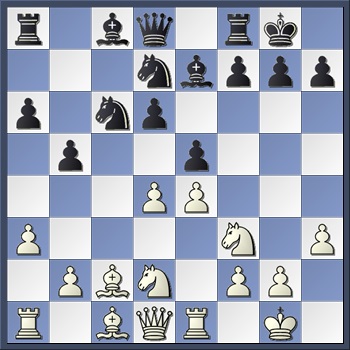
14…exd4
Now Golombek follows up with yet another non-Keres note:
‘With this pawn exchange Black accepts the handicap of a weakness on d6 so as to obtain good play with his pieces in compensation. Another move that also came into consideration was 14…Bf6, so as to meet 15 d5 with 15…Ne7.’
Well, the first sentence is appropriate but not the second – which also seems to have been copied from Romanovsky’s notes in the Russian bulletins of Curaçao – as Keres’ pre-determined plan was to seek active piece play in an open centre, not to lock up his pieces in a closed position.
15 Nb3 Nde5
16 Nfxd4
Tal: ‘Worse is 16 Nbxd4 Nxf3+ 17 Nxf3 Be6.’
16…Bf6
Golombek here essentially repeats himself with another note of his own:
‘Now Black exerts marked pressure along the diagonal h8-a1 and has approximately equalised the chances. The good play with the pieces fully compensates for the pawn weakness on d6.’
Incidentally, Zenón Franco in his new book also follows Golombek’s fake version of Keres’ notes from moves 11 to 16.
17 Bd2
Shockingly, matters get even worse at this moment with Golombek proceeding to directly contradict Keres by writing:
‘17 Bd2? [note the punctuation mark] Tal tries for the biggest possible complications in every position and simply cannot leave any chance untouched of bringing them about. The combination initiated by the text-move is indeed very complicated, but it eventually turns to Black’s advantage. It would therefore have been more advisable, by 17 Nxc6 Nxc6 18 Rb1, to have relieved the pressure on his b2 and thus prepared for the development of his queen’s bishop.’
You see, Keres’ note should read:
‘I find it hard to believe the statement of some commentators that in playing this move Tal overlooked the possibility of the subsequent complications. Most probably he provoked them on purpose, considering them to be favourable for White.
If now, after home analysis, it becomes clear that the arising complications are favourable for Black, then Tal cannot be reproached for that. Therefore I consider it incorrect to place a question mark by this move: it leads to a lively game with chances for both sides, which will be highly appreciated by chess amateurs. In the event of the ‘correct’ continuation 17 Nxc6 Nxc6 18 Rb1 the chess world would have been denied one of the most interesting games of the Curaçao tournament.’
Timman wrote in his highly atmospheric book on Curaçao, published by New in Chess: ‘It seems to me that the modest 17 Rb1 is White’s best bet, as the position is now balanced.’
Funnily enough, in direct contrast, Tal actually gave an exclamation mark to 17 Bd2!, adding:
‘Probably the only way to fight for an opening advantage, although, together with this, White risks a quick defeat (as, indeed, happens in the game). Not seeing another way to maintain the centralised knight since Black threatens an exchange on d4 followed by …Qb6, and against the recommendation of many commentators, I rejected 17 Nxc6 Nxc6 18 f4 ‘with a good position’ because of the simple 18…Be6, and it is not at all clear where are the pluses of White’s position. Surely not the position of the knight on b3?! Now White is getting ready to transfer the bishop to c3, after which, with support from the knight on d4, he can occupy himself with preparations for an assault on the kingside. If Black does not want to end up in the worse position, he is forced to go for complications.
After long deliberation Keres played. . .’
17…Nxd4 18 Nxd4
18…Nd3!
Here Golombek continues to contradict what Keres actually wrote:
‘With this Black falls in with the designs of his opponent, in the belief that the ensuing complications are good for him. The game now becomes very interesting.’
In reality, there was no such ‘belief’ as Keres admitted he could not calculate precisely what lay ahead:
‘During the game, this move gave me quite a lot of trouble. The fact of the matter is that its consequences were far from clear to me, particularly in an encounter with such a master of attack as Tal. But, on the other hand, despite long deliberation, I did not find a refutation of my idea. Therefore now, from a principled point of view, I felt duty bound to verify the correctness of my opponent’s idea. For me, certainly, the thought never entered my mind that Tal might have simply overlooked this move.’
19 Nc6
Tal:
‘When thinking over my 17th move, I assessed the arising complications in my favour, but if, upon closer inspection, this assessment turns out to be mistaken, White would have the “reserve” possibility, 19 Ba5 Qxa5 20 Qxd3 g6 21 Rad1, and there can be no talk about an advantage for either side. Now, following the move in the game, Black must play combinatively, since after 19…Qb6 20 Bxd3 Qxc6 21 e5 Bxe5 22 Be4 d5 23 Bxh7+ Kxh7 24 Rxe5, the presence of opposite coloured bishops obviously favours White.’
Golombek’s translation at this point is yet again off the mark and misleading:
‘This move cannot really be considered as a mistake since it belongs to the plan White has formulated. Continuations such as 19 Ba5 Qxa5 20 Qxd3 g6, or 19 Bxd3 Bxd4 20 Rb1 Qf6, painfully striving after equality, are naturally not calculated to substantiate the correctness of White’s 17th move.’ (Incidentally, here Timman points out that instead of 20 Rb1, White can play 20 Qc2 Qf6 21 Bc3 Bxc3 22 Qxc3 Qxc3 23 bxc3 Be6 24 a4 and force a draw.)
But, in The Life and Games of Mikhail Tal, the former world champion writes:
‘With one half of the tournament gone, I had moved up one place – to last but one! – with 4½ points. However, the leaders had “only” 9! I spent the two-week break still hoping to rest and regain my form, and with the belief that I would win almost every game in the 3rd and 4th cycles.’
Shortly after John Nunn had algebraicised the Keres book, he performed the same task for The Life and Games of Mikhail Tal on behalf of the publisher Cadogan. This is a famous work yet he did not insert a footnote referring to these highly significant remarks made by Tal about his awful start in the Curaçao Candidates and the bearing it had on his attitude towards the present game.
It should be added that a little later, after his eventual defeat, Tal’s mood changed dramatically:
‘The game with Keres was the last one that I played with any hope of success in the tournament. By success, I mean only first place.
I thought up a very interesting combination, and after making a preparatory move, I even went up to Petrosian and joked: “I’m going for the brilliancy prize”. The point was that, in my preliminary calculations, I was planning to sacrifice my queen for only two minor pieces, but after writing down Qh5, which would have led to the sacrifice, I instead changed my mind and played Qf3, forgetting about Black’s obvious reply, Within two moves, not a trace of my attack remained, but I was a pawn down, and soon had to resign.
It was only then that it became clear to me that it was time to give up the tournament as lost. . .’
Thus there was no question of Tal ever ‘striving after equality’ as was also clearly conveyed by the following correct rendition of Keres’ annotation:
Keres:
‘Also this move was criticised. White was advised to play either 19 Ba5 Qxa5 20 Qxd3 g6, or 19 Bxd3 Bxd4 20 Rb1 Qf6 – in both cases with an acceptable position for Black. But upon this the critics forget that 19 Nc6 entered into White’s plan beginning with the 17th move and that Tal would have hardly chosen the continuation 17 Bd2, if he had been striving only for equality.’
19…Nxf2!
Tal:
‘In his comments to this game, M. Yudovich wrote the following: “Tal did not notice this tactical blow – clear evidence of the bad sporting form of the ex-world champion.” I am not going to argue with the commentator over the second part of this sentence. Indeed, in this tournament it is possible to find quite a lot of “evidence” of “the poor form of the ex-world champion”, so there the commentator was not guessing. But White did in fact consider the complications arising after 19…Nxf2, assessing them favourable for himself, and only at the last moment did he refrain from playing his previously intended variation.’
Keres:
‘The idea of Black’s defence. By now he had no choice, since 19…Qb6 20 Bxd3 Qxc6 21 Rc1 is in White’s favour.’
20 Qf3
Here it is interesting to quote Jan Timman’s response to Tal’s above-mentioned comments:
‘Is it really true that the alternative 20 Qh5 would have led to a promising queen sacrifice? I decided to have the queen move checked by the computer, which came up with the following main line: 20 Qh5 Nxh3+
21 Kh2 g6 22 Qf3 Be5+ 23 Nxe5 dxe5, and Black is superior by far.’
Interestingly, this assertion gave rise to a lively debate on the chessgames.com forum where hesam 7 continued the line with 24 Bb4 Nf4! 25 Bxf8 Kxf8 26 Qe3 with the view that ‘Black is better but not that much especially if White succeeds in exchanging the heavy pieces.’
Timman then continued:
‘So where was the queen sacrifice Tal had in mind? After some thinking I discovered it. Let’s say that Black does not play the computer move 21…g6, but moves his queen, e.g. 21…Qc7.
Play then continues 22 e5 g6 23 exf6 [incidentally, White can also proceed 23 Qf3 Bh4 24 gxh3 Bb7 25 Be4 Bxe1 26 Rxe1 with interesting play] 23…gxh5 24 gxh3 Qxc6 25 Be4 Qd7 26 Re3
and White gets a very strong and probably decisive attack.’
To which, again on chessgames.com, tamar responded: ‘I think this is one of Timman’s mistakes. White is losing after his line, 25…d5 and 26…d5 both look very strong.’
Finally, at the end of his annotations to the whole game, Timman added a postscript including the analysis by Tal and Keres, which we give in the next note, and explaining:
‘It was only after writing my comments on 20 Qh5 that I discovered that the game was published with brief comments by Tal, after Round 25, Tal must have written his comments on his sickbed!’
Well, yes, and we might add perhaps after analysing the game with Bobby Fischer, who was the only one of the players to visit Tal in hospital!
The only player to visit Tal in hospital at the Curaçao Candidates was Bobby Fischer – who later criticised Keres for something he didn’t write!
(Photo by Richard C. Cantwell in the tournament book published by New in Chess)
Anyway, a correct translation of Keres’ note explains the true situation:
Keres:
‘A critical moment. Obviously White had the choice only between two continuations – 20 Qf3 and 20 Qh5, since 20 Nxd8 or 20 Kxf2 Qb6+ are not worth looking at.
In the end the move in the game proves to be insufficient, and therefore it is necessary to turn our attention to the possibility of 20 Qh5. Indeed the position after 20 Qh5 is so complex that even after lengthy home analysis it is difficult to determine whose chances are better. After the game many commentators asserted that 20 Qf3 was the decisive mistake and that White could decide the struggle in his favour by 20 Qh5. But how do matters really stand?
During the game of course I considered the possibility 20 Qh5 and, if my memory does not deceive me, I intended to reply 20…Qb6. This move seems very natural, since 20…g6 is no good because of 21 Qf3. But in reply to 20…Qb6 Tal had prepared the following beautiful variation: 21 e5!
21…Ne4+ (but not 21…Nd3+ 22 Be3 Qxc6 23 exf6 Qxc2 24 Qg5 with unavoidable mate) 22 Kh2 (or 22 Be3 Qxc6!)
22…g6, and now not 23 Qe2 Qxc6 24 Bxe4 Bxe5+ 25 Kh1 d5 etc., but the significantly stronger – 23 exf6! gxh5 24 Bxe4,
and it seems that White’s attack compensates for the sacrificed material.
But this beautiful variation has one essential defect, it is not forced. Black is not obliged to win the queen and can instead of 22…g6 continue 22…Bxe5+ 23 Nxe5 Nf6!.
After the further 24 Qh4 dxe5 25 Bc3 (or 25 Bg5 h6) 25…Re8 or 24 Qf3 Bb7 (even 24…dxe5 25 Qxa8 Bb7 etc. is possible) Black has nothing to fear.
[Here John Nunn gives one of his analytical footnotes, and a brilliant one at that:
‘In this line White has a possible improvement by 24 Bxh7+ Nxh7 25 Ng6!. Since 25…Rd8 26 Ne7+ Kh8 27 Qxf7 is bad for Black, he must go in for 25…fxg6 26 Qd5+ Kh8 27 Qxa8 Bb7.
At first sight White is losing his queen, but he has the incredible resource 28 Qe8! when 29…Rxe8 29 Rxe8+ Nf8 30 Rf1 is somewhat better for White. Therefore Black should reply 28…Bxg2, but the fun isn’t quite over because White has the resource 29 Be3!; after 29…Rxe8 (Black doesn’t have a really good square for his queen) 30 Bxb6 Be4 the ending is slightly better for White.’]
However, a more significant blow was delivered to the variation 20 Qh5 in later analysis. The fact is that Black can play 20…Nxh3+!
so as on 21 gxh3 or 21 Qxh3 to reply 21…Qb6+. After 21 Kh2 the continuation 21…Be5+ is insufficient because of 22 Qxe5! dxe5 23 Nxd8 Rxd8 24 Ba5 etc., but 21…g6! appears to completely refute White’s attack.
After this the try 22 Qxh3 Be5+ followed by 23…Qc7 or 22 Qd5 Qd7 and 23…Bb7 is obviously insufficient, while the position after 22 Nxd8 gxh5 is also not very attractive for White. There remains only 22 Qf3, but then 22…Be5+! leads to the game continuation with the insignificant difference that the black g7 pawn is standing on g6 (23 Nxe5 dxe5 24 Bh6 Qh4! etc.).
The foregoing analysis shows that Black has also in the case of 20 Qh5 sufficient defensive resources. But this, of course, is analysis after the game. Even now it is hard to predict how things would have turned out over the board, particularly if it is taken into account that both opponents cannot remember accurately their intentions during the game.’
Golombek gives most, but not all, of this foregoing analysis, in his own fashion, but does not relay correctly or completely what Keres actually wrote or what was really going on in the minds of the players. He simply sums up:
‘It is a great pity that Tal did not choose the main variation here, 20 Qh5!, which would have led to well-nigh unfathomable complications.’
And then, after giving the queen sacrifice line, concludes: ‘This variation serves as a refutation of those critics who wished to characterise Tal’s previous moves as complete oversights.’ But, funnily enough, Golombek, annotating the game in the British Chess Magazine, in 1962, himself claimed that Tal had overlooked 18…Nd3!, so he was one of the ‘critics’ too!
However, Keres does not mention the explanation that Tal gives for his rejection of 20 Qh5:
‘After 20 Qf3 Black wins by force. In his preliminary calculations White intended to continue 20 Qh5. Now on 20…g6, there is the decisive 21 Qf3, while in the case of 20…Qb6, the following variation is possible: 21 e5 Ne4+ 22 Kh2 g6 [of course this was written in 1962 before Keres published his refutation: 22…Bxe5+ 23 Nxe5 Nf6!] 23 exf6! gxh5 24 Bxe4 Bb7 25 Ba5
25…Qxc6 (otherwise White takes a third piece) 26 Bxc6 Bxc6 27 Rad1 with advantage to White. If Black continues as in the game, 20…Nxh3+ 21 Kh2 Be5+ 22 Qxe5 dxe5 23 Nxd8 Rxd8, once again would follow 24 Ba5 with material gain.
Checking the last variation, I suddenly “discovered” that Black could play 24…Nf4!?? 25 Bxd8 Rxd8!!!, and with two pawns for the exchange he also maintains a defensible position. This assessment may even be correct, but unfortunately 25…Rxd8 is not quite in accordance with the laws of chess. [There is a curious similarity here to the exchange sacrifice recommended by hesam7!]. Once again I had to occupy myself with a study of the move 20 Qf3, which likewise seemed tempting for White but also here there was a hidden flaw.’
20…Nxh3+!
Keres:
‘Here too this is the refutation of White’s idea. In case of 20…Qb6 Tal again had in mind 21 e5! with the possible continuation 21…Ng4+
22 Be3! (No good is 22 Kh1 Nxe5 23 Nxe5 Bxe5 24 Rxe5 dxe5 25 Qxa8 Bb7 26 Bxh7+ Kxh7 27 Qxf8 Qf2! 28 Rg1 Qg3 etc.) 22…Nxe3 23 exf6! Nxc2+ 24 Kh2 Nxe1 25 Rxe1 and, despite the minus rook, White has a very dangerous attack.’
Tal elaborated further:
‘This too, White had seen. A very interesting position arises after 20…Qb6 (instead of 20…Nxh3+) 21 e5 Ng4+! 22 Kh1. Curiously, if the white a-pawn were instead on a2, White would win by 22…Nxe5 23 Nxe5 Bxe5 24 Rxe5 dxe5 25 Qxa8 Bb7
A supposed position!
26 Bxh7+! (26 Ba5 or 26 Be3 fail to 26…Qc6) 26…Kxh7 27 Qxf8 Qf2 28 Rg1 Qg3 29 Qa3!. Unfortunately, in reality White does not have this defence, and mate is inevitable. I intended to continue 22 Be3 Nxe3 23 exf6
23…Nxc2+ (Black cannot win a piece as 23…Nd5+ 24 Kh2 Qxc6 loses to 25 Bxh7+! Kxh7 26 Qh5+ Kg8 27 fxg7 Kxg7 28 Qg5+ Kh7 29 Re4) 24 Kh2 Nxe1 25 Rxe1.
This position seemed very attractive to me, since, despite his extra rook, it is difficult for Black to defend against the many threats. For example, no good is 25…Bb7 26 Ne7+ Kh8 27 fxg7+ Kxg7 28 Qg3+ Kh8 (28…Kf6 allows mate in three moves) 29 Nf5! Rg8 30 Qc3+.
Upon the text move White intended to continue 21 Kf1, as he thought it won a piece.’
21 Kh2
Tal continues. . .
‘So why did White reject his intended continuation? The fact of the matter is that in the variation 21 Kf1 Qb6 22 e5 Bg4! 23 Qg3
White had in mind only 23…Qxc6 24 exf6 Qxc2 25 Qxg4 g6 26 Bc3 winning the knight on h3. But then the move 23…Qg1 mate struck me like a bolt from the blue. I completely overlooked that the bishop on g4 cut off the king’s flight square, or, more accurately, I noticed it too late, when the result of the game was already a foregone conclusion. After the text move Black obtains an easily winning position by force.’
Keres:
‘Other moves likewise do not alter matters. On 21 gxh3 or 21 Qxh3 follows, of course, 21…Qb6+, while on 21 Kh1 Qb6 22 e5 the reply 22…Bg4! is very strong.
[Golombek incorrectly translates ‘very strong’ as ‘devastating’ and John Nunn provides a footnote: ‘This move actually provokes unnecessary complications, because White can reply 23 Bxh7+, when 23…Kxh7 24 Qe4+ followed by 25 Be3 provides some counter-chances. Of course, Black can play 23…Kh8, but giving up the h7 pawn can only provide White with counterplay. Instead, 24…Nf2+ 23 Kg1 (23 Kh2 Bg4 really is devastating) 23…Ng4+ 24 Kh1 dxe5 is the most convincing line, with an easy win for Black.]
During the game Tal at first intended to play 21 Kf1, but upon this equally follows 21…Qb6 22 e5 Bg4!.
Now both 23 Be3 Bxf3 24 Bxb6 Bxc6, and 23 Qe3 Qxc6 24 Rac1 Qc4+ 25 Bd3 Qf4+ give Black sufficient advantage for a win.’
But John Nunn writes:
‘Once again, White can play 23 Bxh7+!. After 23…Kh8 (23…Kxh7 24 Qe4+ and 25 Be3 is unclear) 24 Qe3 Qxc6 25 exf6 Kxh7 26 Qe4+ Qxe4 27 Rxe4 Bf5 28 Rd4 gxf6 29 gxh3 Bxh3+ 30 Kf2 the ending offers no winning chances for Black despite his three extra pawns(!), for example 30…Bf5? 31 Rh1+ Kg8 32 Rf4!, followed by Bc3, and Black is actually losing. At any rate, White should certainly have tried this line.’
But of course, as Tal explained, he had initially dismissed 21 Kf1 on the grounds of a reply that would have led to him being instantly checkmated!
21…Be5+!
Keres:
‘The moment Black has succeeded in eliminating the threat of e4-e5, White’s attack is at an end. Now White is forced to exchange on e5, since after 22 Kh1 Qc7 Black retains his material advantage (23 Bb3 Qxc6 24 Bd5 Qc2 etc.)’
Golombek gave instead: ‘The simplest way of foiling the enemy attempt at attack’, whilst adding a variation of his own, after 22 Kh1, i.e. 22…Qh4 23 gxh3 Bg3! 24 Ne7+ Kh8 25 Nxc8 Raxc8, as an alternative winning line for Black.
Tal simply wrote: ‘On 22 Kh1 the simplest is 22…Qc7.’ For the record, the computer says that Black is in fact only slightly better here.
22 Nxe5 dxe5 23 Red1
Keres: ‘White has no time for gxh3, since the bishop on d2 is hanging. But in the event of 23 Bb4 the intermediate move 23…Ng5 saves the exchange.’
23…Nf4!
Keres: ‘Finally consolidating Black’s advantage, since after 24 Bxf4 or 24 Bb4 Black has the reply 24…Qh4+. Now the struggle can be considered to be at an end, since with two extra pawns Black’s position is clearly winning.’
24 g3 Ne6 25 Bc3
Keres: ‘In case of 25 Bb4 Black has the defence 25…Nd4.’
25…Qg5
26 Rd6
Keres: ‘An oversight in a losing position. If 26 Rd5 Black could commence a dangerous attack on the king by 26…Qh6+ and 27…Ng5.’
Tal:
‘Losing the exchange. But in the present position this has no significance at all. The final moves in the game were made in mutual time pressure, more severe for White, as Black had spent a great deal of time on calculation, and White on both calculation and reflection on his experiences in the game. Therefore some inaccuracies made by my opponent in realising his advantage, and also White’s stubborn reluctance to resign before the time control, can easily be explained. The final moves can be understood without any further comments.’
26…Qh6+
27 Kg1
Keres: ‘Or 27 Kg2 Nf4+ 28 gxf4 Qxd6 with the same result.’
27…Nd4
Keres: ‘Winning the exchange as well. The following moves were made in mutual time-trouble.’
In other words both players were in time-trouble and therefore susceptible to making errors, not just Keres. However, Golombek rather changed the meaning by writing:
‘Winning the exchange, after which further resistance is hopeless. Tal makes some more moves in the hope that his opponent might perhaps commit an inaccuracy under time-pressure.’
But this introduced an implication that Keres never intended because, as Tal stated, it was he himself who was in the more severe time pressure and he was only playing on due to his ‘stubborn reluctance to resign before the time control’.
28 Rxh6 Nxf3+ 29 Kf2 gxh6 30 Kxf3 Re8 31 Rh1 Kg7 32 Bb3 Bb7
Keres: ‘Technically simpler was 32…a5, preparing the defence 33…Ra6.’
33 Bd2 f5 34 Rxh6 Rad8 35 Rb6 Bxe4+ 36 Ke2 Bf3+ 37 Ke1
37…f4
Keres: ‘Not giving the opponent the possibility of activating his bishop by 38 Bh6+.’
38 Bc3 fxg3 39 Rxa6 Rd4 40 Ra7+ Kh6 41 Rf7
Keres: ‘White resigned without waiting for his opponent’s reply. A very interesting game, rich in content.’
* * * * *
Lest I give the wrong impression in this article, I should conclude by saying that I am a big fan of Harry Golombek’s work. I learned so much from his books when I was young and enjoyed my conversations with him over the years, listening avidly to the tales he had to tell about the old masters. I only discovered the fake annotation in 2016 when I was looking through all sorts of old material on Keres as a way of participating in the celebrations of the 100th anniversary of his birth. It’s just a pity that I was not aware of the Curaçao mystery when Harry was alive as I will now forever wonder what explanation he would have come up with if I had challenged him on this point. Unfortunately all this was not to be as he passed away in 1995 on January 7th – the same date as Paul Keres was born!

